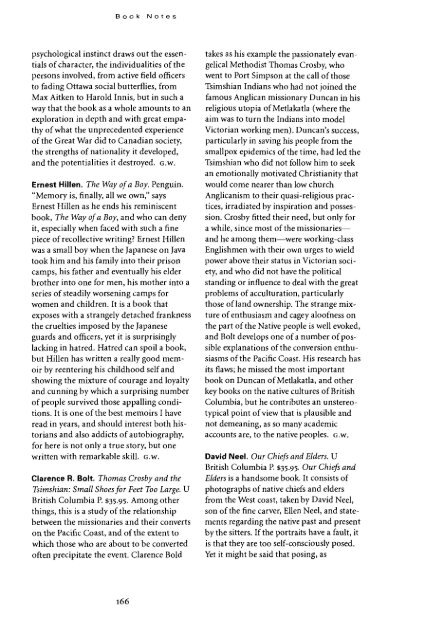To All Appearances A Lady - University of British Columbia
To All Appearances A Lady - University of British Columbia
To All Appearances A Lady - University of British Columbia
Create successful ePaper yourself
Turn your PDF publications into a flip-book with our unique Google optimized e-Paper software.
Book<br />
Notes<br />
psychological instinct draws out the essentials<br />
<strong>of</strong> character, the individualities <strong>of</strong> the<br />
persons involved, from active field <strong>of</strong>ficers<br />
to fading Ottawa social butterflies, from<br />
Max Aitken to Harold Innis, but in such a<br />
way that the book as a whole amounts to an<br />
exploration in depth and with great empathy<br />
<strong>of</strong> what the unprecedented experience<br />
<strong>of</strong> the Great War did to Canadian society,<br />
the strengths <strong>of</strong> nationality it developed,<br />
and the potentialities it destroyed, G.W.<br />
Ernest Hillen. The Way <strong>of</strong> a Boy. Penguin.<br />
"Memory is, finally, all we own," says<br />
Ernest Hillen as he ends his reminiscent<br />
book, The Way <strong>of</strong> a Boy, and who can deny<br />
it, especially when faced with such a fine<br />
piece <strong>of</strong> recollective writing? Ernest Hillen<br />
was a small boy when the Japanese on Java<br />
took him and his family into their prison<br />
camps, his father and eventually his elder<br />
brother into one for men, his mother into a<br />
series <strong>of</strong> steadily worsening camps for<br />
women and children. It is a book that<br />
exposes with a strangely detached frankness<br />
the cruelties imposed by the Japanese<br />
guards and <strong>of</strong>ficers, yet it is surprisingly<br />
lacking in hatred. Hatred can spoil a book,<br />
but Hillen has written a really good memoir<br />
by reentering his childhood self and<br />
showing the mixture <strong>of</strong> courage and loyalty<br />
and cunning by which a surprising number<br />
<strong>of</strong> people survived those appalling conditions.<br />
It is one <strong>of</strong> the best memoirs I have<br />
read in years, and should interest both historians<br />
and also addicts <strong>of</strong> autobiography,<br />
for here is not only a true story, but one<br />
written with remarkable skill, G.W.<br />
Clarence R. Bolt. Thomas Crosby and the<br />
Tsimshian: Small Shoes for Feet <strong>To</strong>o Large. U<br />
<strong>British</strong> <strong>Columbia</strong> P. $35.95. Among other<br />
things, this is a study <strong>of</strong> the relationship<br />
between the missionaries and their converts<br />
on the Pacific Coast, and <strong>of</strong> the extent to<br />
which those who are about to be converted<br />
<strong>of</strong>ten precipitate the event. Clarence Bold<br />
takes as his example the passionately evangelical<br />
Methodist Thomas Crosby, who<br />
went to Port Simpson at the call <strong>of</strong> those<br />
Tsimshian Indians who had not joined the<br />
famous Anglican missionary Duncan in his<br />
religious Utopia <strong>of</strong> Metlakatla (where the<br />
aim was to turn the Indians into model<br />
Victorian working men). Duncan's success,<br />
particularly in saving his people from the<br />
smallpox epidemics <strong>of</strong> the time, had led the<br />
Tsimshian who did not follow him to seek<br />
an emotionally motivated Christianity that<br />
would come nearer than low church<br />
Anglicanism to their quasi-religious practices,<br />
irradiated by inspiration and possession.<br />
Crosby fitted their need, but only for<br />
a while, since most <strong>of</strong> the missionaries—<br />
and he among them—were working-class<br />
Englishmen with their own urges to wield<br />
power above their status in Victorian society,<br />
and who did not have the political<br />
standing or influence to deal with the great<br />
problems <strong>of</strong> acculturation, particularly<br />
those <strong>of</strong> land ownership. The strange mixture<br />
<strong>of</strong> enthusiasm and cagey alo<strong>of</strong>ness on<br />
the part <strong>of</strong> the Native people is well evoked,<br />
and Bolt develops one <strong>of</strong> a number <strong>of</strong> possible<br />
explanations <strong>of</strong> the conversion enthusiasms<br />
<strong>of</strong> the Pacific Coast. His research has<br />
its flaws; he missed the most important<br />
book on Duncan <strong>of</strong> Metlakatla, and other<br />
key books on the native cultures <strong>of</strong> <strong>British</strong><br />
<strong>Columbia</strong>, but he contributes an unstereotypical<br />
point <strong>of</strong> view that is plausible and<br />
not demeaning, as so many academic<br />
accounts are, to the native peoples, G.W.<br />
David Neel. Our Chiefs and Elders. U<br />
<strong>British</strong> <strong>Columbia</strong> P. $35.95. Our Chiefs and<br />
Elders is a handsome book. It consists <strong>of</strong><br />
photographs <strong>of</strong> native chiefs and elders<br />
from the West coast, taken by David Neel,<br />
son <strong>of</strong> the fine carver, Ellen Neel, and statements<br />
regarding the native past and present<br />
by the sitters. If the portraits have a fault, it<br />
is that they are too self-consciously posed.<br />
Yet it might be said that posing, as<br />
166

















